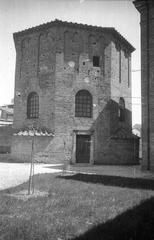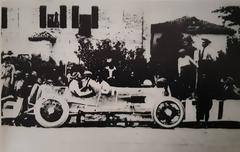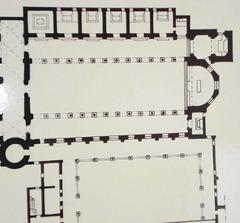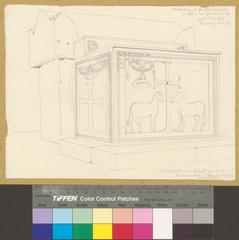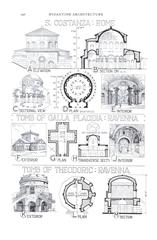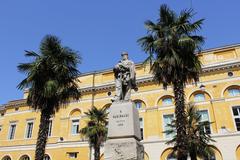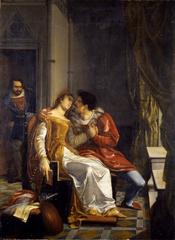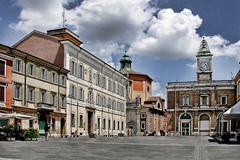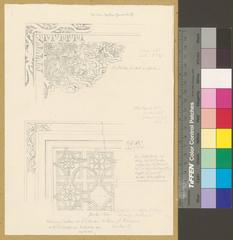Pala De André Visiting Hours, Tickets, and Ravenna Historical Sites Guide
Date: 04/07/2025
Introduction: Discovering Pala De André’s Significance
In the historic city of Ravenna, Italy, the Palazzo Mauro De André—widely known as Pala De André—emerges as a symbol of contemporary culture and modern architectural achievement. Since its opening in 1990, this multipurpose arena has evolved from a sports venue into a central stage for concerts, exhibitions, conferences, and international festivals. Its iconic 33-meter high translucent dome and the monumental “Grande Ferro R” sculpture by Alberto Burri anchor the venue in both Ravenna’s maritime legacy and its vibrant, artistic present.
Pala De André is strategically located at Viale Europa 1, just minutes from Ravenna’s UNESCO World Heritage sites such as the Basilica di San Vitale and the Mausoleum of Galla Placidia. Designed by architect Carlo Maria Sadich, the arena masterfully integrates functional design with artistic elements, making it an essential stop for culture enthusiasts and event-goers. As the principal venue for the annual Ravenna Festival, it hosts world-renowned performances, contributing significantly to the city’s reputation as a cultural destination.
This guide offers a comprehensive overview of Pala De André’s history, architecture, practical visitor information, and its broader cultural context—equipping travelers with the knowledge to fully experience one of Ravenna’s most celebrated landmarks. For the latest schedules and event updates, consult official sources such as the Ravenna Festival and Turismo Ravenna.
Table of Contents
- Introduction
- Historical Background
- Architectural Design and Artistic Features
- Event Hosting and Visitor Experience
- Practical Information: Hours, Tickets, and Access
- Accessibility and On-site Services
- Cultural Significance and Nearby Attractions
- Quick Reference: FAQs
- Tips for an Optimal Visit
- Visuals and Media Resources
- Conclusion
Historical Background
Pala De André is a direct result of Ravenna’s late-1980s ambition to modernize its event infrastructure. Initially envisioned as a sports arena for the 1990 FIFA World Cup and designed by renowned architect Renzo Piano, the project was delayed by bureaucratic obstacles (Wikipedia). Industrialist Raul Gardini, president of Enimont, stepped in to finance a new arena, which was ultimately dedicated to Mauro De André—a Ferruzzi executive and the brother of celebrated singer-songwriter Fabrizio De André, following Mauro’s untimely passing in 1989. The building was completed in record time, and its inauguration in October 1990 marked a new era for Ravenna’s cultural scene (Google Arts & Culture).
Architectural Design and Artistic Features
Vision and Concept
Architect Carlo Maria Sadich brought a refined approach to Pala De André, blending functionality with aesthetic symbolism. He drew inspiration from Ravenna’s seafaring history and Dante Alighieri’s literary legacy, making the venue a rare example of contemporary architecture in a city steeped in Byzantine tradition (Ravenna Festival).
Layout and Adaptability
The arena occupies a 12-hectare site close to both industrial districts and the city center. Its most distinctive feature is the 33-meter high, square-based dome constructed with a metal framework and covered in translucent fiberglass, flooding the interior with natural light (Ravenna Festival). The versatile interior seats 3,800 spectators but can be reconfigured for a wide range of events—from sports to concerts and exhibitions—thanks to mobile stands and modular spaces (Wikipedia).
Signature Artworks
- Grande Ferro R by Alberto Burri: A monumental sculpture of two stylized hands forming an overturned ship’s keel, representing Ravenna’s maritime identity (Google Arts & Culture).
- The Danteum Entrance: A hypostyle hall of 100 pillars, with symbolic materials referencing Dante’s Divine Comedy: red iron (Inferno), Carrara marble (Purgatorio), and crystal (Paradiso) (Ravenna Festival).
- Mosaic Artworks: Interior mosaics by Elisa Montessori and Luciana Notturni celebrate Ravenna’s ancient artistic tradition (Ravenna Festival).
- Travertine Fountains: Designed by Ettore Sordini, these add elegance and serenity to the complex (Turismo Ravenna).
Event Hosting and Visitor Experience
Pala De André is renowned for its versatility:
- Sports: Historically hosted teams like Porto Ravenna Volley and Basket Ravenna Piero Manetti (Wikipedia).
- Music and Performing Arts: Enhanced acoustics allow for orchestral concerts, including the inaugural 1990 performance and Riccardo Muti’s celebrated events (Ravenna Festival).
- Art Exhibitions: Past shows include notable retrospectives such as Giorgio De Chirico’s in 2008 (Wikipedia).
- Conferences: Hosts major international meetings, such as the OMC Med Energy Conference (Expoclima).
Practical Information: Hours, Tickets, and Access
- Location: Viale Europa 1, Ravenna, Italy (OMC Venue).
- Visiting Hours: The venue opens in alignment with event schedules, typically an hour before performances. For conferences and exhibitions, hours are usually 9:00 am–7:00 pm. Always check the official website or event calendar (Ravenna Festival).
- Tickets: Purchase online via official event websites or at the box office. Prices vary (generally €15–€100), with discounts for students and seniors for select events (Visit Romagna).
- Guided Tours: Not regularly scheduled, but may be available during festivals or special events. Inquire with organizers.
Getting There
- By Train: Ravenna’s main station is 15 minutes away on foot or a short bus ride.
- By Shuttle: Free shuttle coaches run from the train station during major events (Ravenna Festival).
- By Car: Ample free parking adjacent to the venue; city blue-line parking is pay-and-display (OMC Venue).
Accessibility and On-site Services
- Wheelchair Access: Ramps, elevators, and adapted restrooms are available throughout the complex (Turismo Ravenna).
- Assistance: Multilingual staff provide support during large events.
- On-site Amenities: Cloakrooms, refreshment areas, Wi-Fi (for conferences), and information desks.
Cultural Significance and Nearby Attractions
Pala De André represents a bridge between Ravenna’s ancient and modern identities. Its innovative architecture and embedded artworks echo the city’s tradition of artistic excellence and cultural diversity. The arena’s position near Ravenna’s historic center allows easy access to:
- UNESCO World Heritage Sites: Basilica di San Vitale, Mausoleum of Galla Placidia, and other Byzantine monuments (Arrivalshall).
- Dante’s Tomb: Celebrating the city’s literary heritage.
- Mercato Coperto: For local cuisine and shopping.
Quick Reference: Frequently Asked Questions (FAQ)
Q: What are the visiting hours of Pala De André?
A: Hours depend on events, typically opening one hour before performances. For exhibitions/conferences: 9:00 am–7:00 pm. Confirm on the official website.
Q: How do I buy tickets?
A: Online via event websites or at the box office. Early booking is advised for popular events.
Q: Is the venue accessible for people with disabilities?
A: Yes, with ramps, elevators, and accessible restrooms. Contact ahead for specific needs.
Q: Are guided tours available?
A: Occasionally during festivals or special events; check event listings.
Q: Is there parking?
A: Yes, free parking is available on-site.
Tips for an Optimal Visit
- Plan Ahead: Review event schedules and book tickets early.
- Arrive Early: Allow extra time for parking, security, and exploring art installations.
- Use Public Transport: Especially during festivals and large events.
- Dress Comfortably: For walking between halls and standing during events.
- Check Photography Policies: Restrictions may apply during performances.
- Bring Essentials: Water and snacks, especially during busy events.
Visuals and Media Resources
- High-quality images of the dome, “Grande Ferro R,” and mosaics can be found on the official Turismo Ravenna and Ravenna Festival websites.
- Alt tags should include keywords such as “Pala De André visiting hours,” “Pala De André tickets,” and “Ravenna historical sites.”
- Explore virtual tours and video presentations through official festival and tourism portals.
Conclusion
Pala De André stands as a testament to Ravenna’s enduring spirit of innovation and cultural vitality. Whether attending an international festival, a world-class concert, or exploring contemporary art, visitors are immersed in a unique blend of history and modern creativity. Proximity to UNESCO World Heritage sites enhances the experience, offering a seamless journey between Ravenna’s ancient wonders and its dynamic present.
For the latest event information, ticketing, and accessibility details, visit the official Ravenna Festival website and OMC Venue guide. Download the Audiala app for personalized updates and recommendations, and follow us on social media for exclusive content about Ravenna’s cultural life.
References and Further Reading
- Palazzo Mauro De André – Wikipedia
- Palazzo Mauro De André – Google Arts & Culture
- Ravenna Festival Official Website – Locations: Palazzo Mauro De André
- Pala De André Visiting Hours, Tickets, and Cultural Highlights in Ravenna
- Turismo Ravenna – Grande Ferro Burri and Pala De André
- OMC Venue Guide
- Visit Romagna – Ravenna Festival Event Info
- Ravennaedintorni – Ravenna Festival Coverage
- Teleromagna – Ravenna Festival Coverage
- Expoclima – OMC Med Energy Conference & Exhibition
- Arrivalshall – Visiting Ravenna Travel Guide
